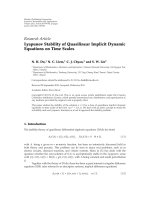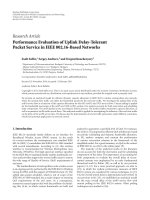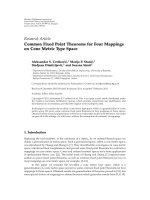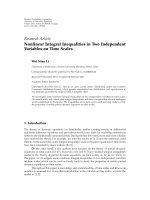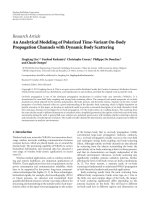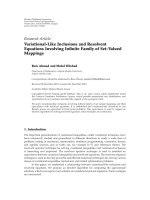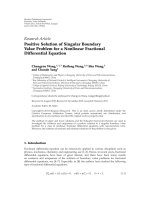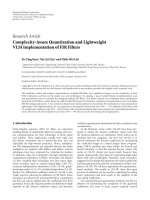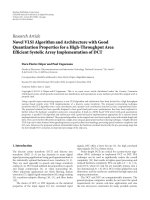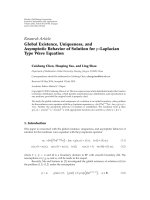Báo cáo hóa học: " Research Article Building Entry Loss and Delay Spread Measurements on a Simulated HAP-to-Indoor Link at S-Band" pdf
Bạn đang xem bản rút gọn của tài liệu. Xem và tải ngay bản đầy đủ của tài liệu tại đây (651.32 KB, 6 trang )
Hindawi Publishing Corporation
EURASIP Journal on Wireless Communications and Networking
Volume 2008, Article ID 427352, 6 pages
doi:10.1155/2008/427352
Research Article
Building Entry Loss and Delay Spread Measurements on
a Simulated HAP-to-Indoor Link at S-Band
F. Perez-Fontan,
1
V. Hovinen,
2
M. Sch
¨
onhuber,
3
R. Prieto-Cerdeira,
4
J. A. Delgado-Pen
´
ın,
5
F. Teschl,
3
J. Kyr
¨
ol
¨
ainen,
2
and P. Valtr
1
1
Department of Signal Theory and Communications, University of Vigo, Campus Universitario, 36200 Vigo, Spain
2
Centre for Wireless Communications, University of Oulu, 90014 Oulu, Finland
3
Institute of Applied Systems Technology, Joanneum Research, Inffeldgasse 12, 8010 Graz, Austr ia
4
Wave Interaction and Propagation Section, European Space Research and Technology Centre (ESTEC), Keplerlaan 1,
2201AZ Noordwijk ZH, The Netherlands
5
Departament de Teoria del Senyal i Comunicacions, Universitat Politecnica de Catalunya, c/Jordi Girona, 08034 Barcelona, Spain
Correspondence should be addressed to P. Valtr,
Received 28 September 2007; Revised 27 February 2008; Accepted 27 June 2008
Recommended by Abbas Mohammed
Results from a measurement campaign emulating the high altitude platform (HAP)-to-indoor communication channel at S-band
are presented inthis paper. A link was established between a transmitter carried by a helicopter, representing the HAP, and a receiver
placed at several locations in different building types including an airport, an office building, a shopping mall, a residential house,
and a skyscraper. A wideband, directive channel sounder was used to measure building entry loss and time delay spread. Results
of the building entry loss are presented as a function of building type, elevation, and building entry angle. Results of delay spread
for each building are also provided.
Copyright © 2008 F. Perez-Fontan et al. This is an open access article distributed under the Creative Commons Attribution
License, which permits unrestricted use, distribution, and reproduction in any medium, provided the original work is properly
cited.
1. INTRODUCTION
High altitude platforms in the form of an airship or an
airplane stationed in stratosphere, about 20 km above the
earth’s surface used to deliver a range of services, are
expected to offer an alternative to terrestrial and satellite-
based communication systems [1]. Although there exist
well-established models for predicting propagation effects in
terrestrial and satellite links that may be applied to the HAP
scenario, specific conditions in the HAP-to-indoor geometry
require further investigation and channel modeling for this
particular application.
Two main issues are of importance when modeling the
outdoor-to-indoor channel, namely, the entry loss and the
delay spreading of the received energy. Entry loss is the
most critical given its very large values, while the delay
spreads are in the order of tens of nanoseconds (ns). Echoes
produced by interactions (reflections, diffractions) with
other buildings will, in general, be negligible in comparison
to the energy entering the building by direct illumination of
its fac¸ade.
The term building entry loss used here corresponds
to the ITU-R Rec. [2, page 1411] definition where it is
defined as the excess loss due to the presence of a building
wall and other building features. Building entry loss largely
depends on the building type, construction, and electrical
parameters of material used. Penetration loss of various
building materials coming from laboratory measurements
at 1–8 GHz can be found in [3]. Electrical parameters of
building materials covering S-band frequencies are reported
in [4, 5]. Many other aspects influence the building entry
loss, like the position of the receiver inside the building,
elevation of the transmitter, and so forth, making it difficult
to accurately estimate the level of received power inside
a building. Nevertheless, decrease of the entry losses into
building with floor height can often be observed [6, 7].
Measured building entry loss in the frequency range close to
2 GHz can be found in [8, 9]. Measurements of rms delay
spread of received signal within buildings close to S-band
frequencies are reported in [10, 11].
In this paper, an attempt has been made to present
values of building entry loss for different buildings varying
2 EURASIP Journal on Wireless Communications and Networking
in type and material as a function of transmitter elevation
and building entry angle. Values of time delay spread are also
provided.
A single-input multiple-output (SIMO) measurement
campaign has been carried out yielding a unique dataset for
modeling the HAP-to-indoor channel. A helicopter carried
a wideband channel sounder transmitter flying in circles
around a multiple patch antenna receiver located inside a
building. The helicopter was stationary during the measure-
ment procedure. Through power delay profile information,
entry loss and multipath spreading were measured. This
experimental setup has been used in six representative
buildings: a major international airport, a local airport, a
suburban shopping mall, an inner city office building, a city
skyscraper, and a detached residential house.
In Section 2, a description of measurement setup togeth-
er with the procedure of the measured data processing is
provided. Section 3 presents the overall building entry loss,
building entry loss as a function of elevation and entry angle
and the results of time delay spread. Section 4 contains the
conclusions of the presented results.
2. MEASUREMENTS AND DATA ANALYSIS
The building penetration loss and the delay spread were
measured as a function of elevation angle and building entry
angle. All measurements were performed with the helicopter
facing the wall behind which the receiver was placed. The
distance of the helicopter from each building was 1 km or
2 km. The range of elevations and azimuths covered by the
helicopter was from 15
◦
to 60
◦
and from −80
◦
to 80
◦
,
respectively. Building entry angle incorporates both elevation
and azimuth; it is zero for grazing incidence and is equal to
90
◦
when the transmitter is in the direction of the normal to
the building surface.
To clarify the data analysis process, the different data sets
and preprocessing steps taken before the actual analysis are
summarized. The data set consists of a number of “products.”
The Propsound channel sounder [12] from Elektrobit,
(Oulu, Finland) was used, providing an “instantaneous”
data set consisting of one “complex” (I and Q) channel
response versus delay per patch antenna and polarization.
These instantaneous measurements are called cycles. The
channel sounder transmits a pseudorandom sequence where
different code lengths are possible. Depending on the code
length chosen, the update rate of such set (full scan over
all antennas and both polarizations) varies giving rates
ranging from several tens of cycles per second to a few
hundreds.
The transmit antenna was circularly polarized (RHCP)
while the receive antenna consisted of a set of patch antennas
(SIMO) with two orthogonal linear polarizations covering
a surface that approximates a semisphere. From each of the
two linearly cross-polarized measurements, both the received
copolar (RHCP) and cross-polar (LHCP) components can
be calculated. Thus, one instantaneous measurement or
cycle consists of an ensemble of instantaneous individual
antenna complex channel responses obtained through cross-
correlation between a transmitted pseudorandom sequence
Power (dBm)
Outdoor reference measurement
Direct signal
Numerical integration of direct ray contribution
Reflections
Noise floor
Delay (ns)
(a)
Power (dBm)
Indoor measurement
1st cluster
Numerical integration
2nd cluster
Noise floor
Delay (ns)
(b)
Figure 1: Measuring the building entry loss model.
and an identical, internally generated sequence in the
receiver.
The channel sounding process tries to measure the
channel impulse response, h(τ). In channel modeling, it
is usual to assume a sufficiently large bandwidth so that
the impulse response is made up of complex deltas (ideal
channel response). The band limiting effects are considered
later when the impulse response is converted into a tapped
delay line (TDL); fitting the bandwidth requirements of
whatever system has to be simulated. In general, the results
obtainable from the analyses reported should be valid for
systems with RF bandwidths smaller than that of the channel
sounder, that is, 200 MHz (chip rate 100 Mcps). Moreover,
the impulse response is not constant in time but time-
variant, that is, h(t,τ). This imposes some constraints on
the sounding process (the duration of one full instantaneous
measurement or cycle) whereby sounding has to be carried
out at a rate consistent with the rate of change of the channel
(its coherence time). Assuming that the sounding process is
fast enough, it is possible to consider the channel impulse
response to be constant over the duration of one cycle.
F. Perez-Fontan et al. 3
To sound the channel, pseudorandom, noise-like
sequences were used. Ideally, noise has a delta autocor-
relation function. Pseudorandom sequences show very
narrow autocorrelation peaks: a base of the order of
±T
chip
,
the chip duration, and an amplitude equal to the sequence
length, m. The measurement of the channel impulse response
is carried out by computing the cross-correlation between
the received signal and an identical sequence synchronized
with the one at the transmitter. The measurement process
does not exactly provide the ideal channel impulse response
but is approximately the result of the convolution between
the channel impulse response and the code autocorrelation
pulse. Given the narrowness of the cross-correlation pulse,
this processing permits a good approximation of h(τ). The
in-phase and quadrature parts are obtained in this process.
The so-called power delay profile (PDP) is in fact the most
frequently used characterization parameter for the wideband
channel and is given by
P(τ)
≈ 10 log
h(τ)∗w(τ)
2
,(1)
where w(τ) is the channel sunder correlation pulse.
Two kinds of parameters were extracted from the mea-
surements; the first group has to do with the entry loss and
the other with the time dispersion effects. For extracting
the entry loss, the measured averaged power delay profiles
(APDPs) were compared with a reference measurement
carried out outside each building. Averaging took place
over several cycles to remove possible enhancements and
cancellations at particular delays.
In the beginning, to measure the entry loss, the sum of
all samples above the noise floor was calculated both for
the reference outdoor measurement, P
Outdoor
, and the indoor
measurements P
Indoor
, that is,
P
Indoor
= 10 log
τ
10
P
Indoor
(τ)/10
,
P
Outdoor
= 10 log
τ
10
P
Outdoor
(τ)/10
.
(2)
This criterion was later changed to take into account only the
direct, LOS contribution as illustrated in Figure 1.
The entry loss is given by
L
Entry
=
P
Outdoor
+ Δ
d
Outdoor
, d
Indoor
−
P
Indoor
,(3)
where
Δ
d
Outdoor
, d
Indoor
=
20 log
d
Outdoor
d
Indoor
(4)
is a distance correction factor needed when the reference
measurement has been carried out at a different distance
than that used in the indoor measurement. P
Outdoor
(τ)and
P
Indoor
(τ) are the measured APDPs.
Similarly, the averaged PDPs were normalized with
respect to the outdoor reference parameter P
Outdoor
, that is,
P
Indoor
(τ) = P
Indoor
(τ) −
P
Outdoor
+ Δ
d
Outdoor
, d
Indoor
.
(5)
This implies that the direct, line-of-sight (LOS) contribution
power outdoors is assumed to be 0 dB, thus the extracted
model parameters (see Section 3) will be referred to the
conditions just outside the building. Their transformation
intoabsolutevaluesisstraightforward.
3. RESULTS OF BUILDING ENTRY LOSS AND
DELAY SPREAD
The brief description of the buildings where the measure-
ments were performed is as follows.
3.1. Shopping center
A large shopping center in an open area with no high
buildings in the vicinity. External walls are made of rein-
forced concrete. Roof is flat consisting of several layers
including 25 cm thick reinforced concrete, 11 cm thermal
isolation layer, and 5 cm gravel. All internal walls are made
of wallboard. The windows are made of thermal protective
glass. The receiver was located close to the window.
3.2. Residential house
A house in open area with no other houses in close vicinity
with 45 cm thick external walls made of light concrete. Roof
is made of wooden framing covered with concrete roof
tiles. The internal walls are made of 10 cm and 25 cm thick
light concrete. There were in total six different measurement
positions of the receiver within the house all deep in the
building.
3.3. Local airport (Graz airport)
Airport building made of mixture of steel, metal construc-
tion elements, and glass coated with sun protective layer. The
roof is of steel construction covered with metal sheets and
with layer of gravel. Internal walls are made of plasterboard
and glass. First measurement point was airport gate 10 at
ground level with the receiver located close to external glass
wall. Second measurement point was a conference room with
glass wall in the first floor adjacent to a 20 m wide terrace.
3.4. International airport (Vienna airport)
Open construction of reinforced concrete. The roof consists
of concrete layer, thermal isolation, and roofing. Gate area
is separated by glass walls. Windows are made of two-layer
silver coated glass. Aluminium lamellas are placed in front
of the windows as sun protection. There were in total nine
different positions of the receiver within the gate area.
3.5. Office building
Seven-storey building in built-up area. The multipath effects
of surrounding buildings are supposed to be negligible. Walls
made of 18 cm reinforced concrete. Flat roof made of layers
of reinforced concrete, thermal isolation, and gravel. Internal
walls are made of cardboard and plasterboard. The receiver
was placed on the seventh floor in six different positions.
4 EURASIP Journal on Wireless Communications and Networking
10
15
20
25
30
35
Entry loss L
entry
(dB)
Graz airport
conference room
Graz airport
gate 10
Shopping
center
Residential
house
Vienna int. airport
boarding gate
Millenium tower
floor 22
Millenium tower
floor 44
Office
building
Figure 2: Building entry loss; the rectangle represents the mean loss, the line shows the minimum-maximum interval.
10
15
20
25
30
35
Entry loss L
entry
(dB)
Graz airport
conference room
Graz airport
gate 10
Shopping
center
Residential
house
Vienna int. airport
boarding gate
Millenium tower
floor 22
Millenium tower
floor 44
Office
building
15 deg
30 deg
45 deg
60 deg
15 deg
30 deg
45 deg
60 deg
15 deg
30 deg
45 deg
60 deg
15 deg
30 deg
45 deg
60 deg
15 deg
30 deg
45 deg
60 deg
15 deg
30 deg
45 deg
60 deg
15 deg
30 deg
45 deg
60 deg
15 deg
30 deg
45 deg
60 deg
Figure 3: Entry loss values for all buildings as a function of the elevation angle.
3.6. City skyscraper (Millennium tower)
The building is a round tower: open construction of
reinforced concrete. Internal walls are of light construction
with glass elements. Outside mounted fac¸ade is made of
metal grid and glass panels. The windows are made of glass
coated with sun protective layer. Two main measurement
locations were chosen on the 22nd and 44th floor at heights
of 70 m and 130 m from ground, respectively. Measurements
were performed in two rooms on the 22nd floor with two
positions in one room and three positions in the other room.
On the 44th floor, measurements were performed in two
rooms with four receiver positions in one room and three
receiver positions in the other room.
Figure 2 shows the results of building entry loss for each
particular measurement site. The results shown are average
values of the loss for all building entry angles and for all
positions of the receiver within each particular room. The
lowest entry losses were measured in Graz airport conference
room. This is because the room has glass external wall and
is just under the roof. The highest entry loss, on the other
side, was measured for the shopping center. The shopping
center has massive external walls and the room in which
the measurement was performed was under the strengthened
part of the roof which serves as a helicopter pad. Quite
high values of penetration loss for residential house could
be explained by the fact that the positions of the receiver
were deep in the house and not close to windows. The higher
entry loss for 22nd floor of Millennium tower compared to
44th floor follows the rule of decrease of entry loss with floor
level but it could also be explained by larger distance of the
receiver from exterior wall on the 22nd floor. Entry losses for
other measurement sites are in the range of 20–25 dB.
Building entry losses as a function of elevation are shown
in Figure 3. It can be seen that the highest entry losses occur
for the elevation between 15 degrees and 30 degrees with
decreasing loss between 30 degrees and 60 degrees.
Figure 4 shows measured entry losses as a function of
building entry angle for one of the measurement sites,
Graz airport conference room, with linear approximation
included. Figure 5 shows linear approximations of entry
losses dependence on building entry angle for all measure-
ment sites. In general, it is expected that the entry loss
decreases with increasing entry angle since the entry angle
is getting closer to the normal incidence. This assumption is
fulfilled for most of the measurement sites. The 22nd floor of
the Millennium tower is an exception which can be explained
by the fact that the surface of the building is not flat (round
building) and the definition of the building entry angle in
this case is rather unclear. For the shopping center too, the
entry loss is almost constant with the building entry angle.
In Figure 5, overall linear fit to all measured entry losses in all
measurement sites is also depicted excluding the unexpected
results of 22nd floor of the Millennium tower. An empirical
F. Perez-Fontan et al. 5
6
8
10
12
14
16
18
20
22
Entry loss (dB)
10 20 30 40 50 60 70 80 90
Building entry angle (deg)
measurements
linear fit
Figure 4: Entry loss versus building entry angle, Graz airport
conference room.
0
5
10
15
20
25
30
35
Entry loss (dB)
0 20 40 60 80 100
Building entry angle (deg)
Graz airport conference room
Graz airport gate 10
Graz residential house
Graz shopping centre
Vienna office building
Vienna airport
Vienna millenium tower 22nd
Vienna millenium tower 44th
Overall fit
Figure 5: Linear approximations of building entry losses for all
measurement sites.
linear function describing the linear fit can be written in the
form
L
= 28.5 − 0.12·α,(6)
where L is the building entry loss (dB) and α is the building
entry angle going from 0–90 degrees. The building entry loss
for 0 degrees (grazing incidence) is 28.5 dB.
Figure 6 displays average entry loss as a function of the
rms delay spread for each measurement location. It can be
10
15
20
25
30
35
40
45
50
Entry loss (dB)
40 60 80 100 120 140 160
Delay spread (ns)
Graz residential house
Graz shopping centre
Graz airport gate 10
Vienna Millenium tower 22nd
Vienna office building
Vienna Millenium tower 44th
Vienna airport
Graz airport conference room
Figure 6: Average entry loss versus mean delay spread.
observed that the delay spread value is related to the size of
the room in which it was measured, that is, the larger room,
the higher value of delay spread. What can also be seen is the
trend of increasing delay spread with decreasing entry loss.
This could be explained by the fact that with lower entry loss,
the entering rays carry more power and some of them can
be multiple reflected within the room before arriving at the
receiver resulting in longer propagation times and therefore
higher delay spread.
4. CONCLUSIONS
This paper presented results of a measurement campaign
simulating the HAP-to-indoor channel at S-band. A heli-
copter was used to carry the transmitter and SIMO channel
sounder placed inside several buildings was used as a receiver.
Measurement results of building entry loss and delay spread
are presented. Building entry loss measurements in eight
different locations correspond well to the building material
and type of the building, that is, the lighter construction, the
lower loss. The building entry losses as a function of building
entry angle are presented. They follow a general trend of
decreasing loss with the entry angle. Finally, the measured
delay spread in different rooms shows higher delay spreads
forlargerrooms.
ACKNOWLEDGMENTS
This work is being performed under ESA/ESTEC Contract
no. 19769/06/NL/GLC. Some of the authors are members of
COST 297—High Altitude Platforms for Communications
and Other Services (HAPCOS).
6 EURASIP Journal on Wireless Communications and Networking
REFERENCES
[1]T.C.TozerandD.Grace,“High-altitudeplatformsfor
wireless communications,” Electronics & Communication
Engineering Journal, vol. 13, no. 3, pp. 127–137, 2001.
[2] ITU-R Rec. P.1411-3, “Propagation data and prediction
methods for the planning of short-range outdoor radiocom-
munication systems and radio local area networks in the
frequency range 300 MHz to 100 GHz,” March 2005.
[3] W. Stone, “Electromagnetic signal attenuation in construction
materials,” Tech. Rep. NISTIR 6055, National Institute of
Standards and Technology, Gaithersburg, Md, USA, October
1997.
[4] J. Baker-Jarvis, M. D. Janezic, B. F. Riddle, et al., “Measuring
the permittivity and permeability of lossy materials: solids
liquids, building material and negative-index materials,” Tech.
Rep. Note 1536, National Institute of Standards and Technol-
ogy, Gaithersburg, Md, USA, February 2005.
[5] S. Stavrou and S. R. Saunders, “Review of constitutive
parameters of building materials,” in Proceedings of the
12th International Conference on Antennas and Propagation
(ICAP ’03), vol. 1, pp. 211–215, Exeter, UK, March-April 2003.
[6]A.F.DeToledo,A.M.D.Turkmani,andJ.D.Parsons,
“Estimating coverage of radio transmission into and within
buildings at 900, 1800, and 2300 MHz,” IEEE Personal Com-
munications, vol. 5, no. 2, pp. 40–47, 1998.
[7] E. F. T. Martijn and M. H. A. J. Herben, “Characterization
of radio wave propagation into buildings at 1800 MHz,” IEEE
Antennas and Wireless Propagation Letters,vol.2,no.1,pp.
122–125, 2003.
[8] W. J. Vogel and G. W. Torrence, “Propagation measurements
for satellite radio reception inside buildings,” IEEE Transac-
tions on Antennas and Propagation, vol. 41, no. 7, pp. 954–961,
1993.
[9] C. Oestges and A. J. Paulraj, “Propagation into buildings for
broad-band wireless access,” IEEE Transactions on Vehicular
Technology, vol. 53, no. 2, pp. 521–526, 2004.
[10] D. M. J. Devasirvatham, M. J. Krain, D. A. Rappaport, and
C. Banerjee, “Radio propagation measurements at 850 MHz,
1.7 GHz and 4 GHz inside two dissimilar office buildings,”
Electronics Letters, vol. 26, no. 7, pp. 445–447, 1990.
[11] P. Nobles and F. Halsall, “Delay spread measurements within
a building at 2 GHZ, 5 GHZ and 17 GHZ,” in Proceedings of
the IEE Colloquium on Propagation Aspects of Future Mobile
Systems, pp. 8/1–8/6, London, UK, October 1996.
[12] Elektrobit. Propsopund, />
